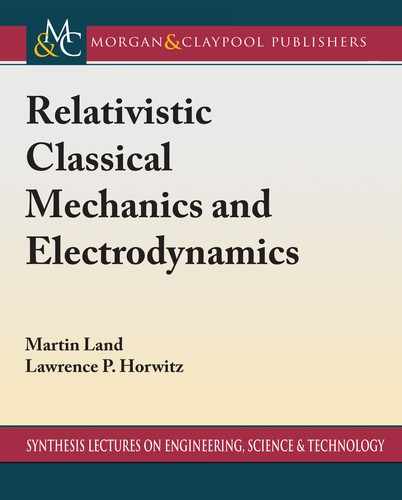
1.2. THE TWO ASPECTS OF TIME 7
1.2 THE TWO ASPECTS OF TIME
As seen in the previous section, curves B and C in Figure 1.1 cannot be parameterized by the co-
ordinate time because they are double-valued in x
0
, and cannot be parameterized by the proper
time of the motion s because s
2
becomes negative in the region of the time reversal point.
Realization of the classical Feynman–Stueckelberg picture thus requires the introduction of a
parameter
entirely independent of the spacetime coordinates—an irreducible chronological
(historical) time, similar in its role to the external time t in nonrelativistic Newtonian mechan-
ics. e simplicity of this picture in accounting for the observed phenomena of pair processes
strongly supports the conclusion [9] that time must be understood as two distinct physical phe-
nomena, chronology and coordinate x
0
. A laboratory clock registers the coordinate time of an
event occurrence much as a 3D array of detectors (meter sticks) registers the event’s coordinate
position.
e chronological time determines the order of occurrence of multiple events, with natural
implications for relations of causality. us, when laboratory equipment reparameterizes the
observed events along curve B in Figure 1.1 by x
0
, two events approaching one another will be
observed at t D t
1
and again at t D 0. But the underlying physics will be determined by field
interactions at the locations of four distinct, ordered events, governed by a microscopic dynamics
such as (1.2) and registered sequentially at t D t
1
, t D 0, again at t D 0, and later at t D t
1
.
In this sense, there are no closed timelike curves in this picture. e so-called grandfather
paradoxes, by which one may return to an earlier time to interfere with the circumstances that
brought about ones own physical presence and agency, are thus resolved. We notice that the
return trip to a past coordinate time x
0
must take place while the chronological time con-
tinues to increase. Since the occurrence of event x
.
1
/ at
1
is understood to be an irreversible
process that cannot be changed by a subsequent event occurring at the same spacetime location,
x
.
2
/ D x
.
1
/ when
2
>
1
, the return trip cannot erase the earlier trajectory. is restriction
is analogous to the conceptually simpler observation in nonrelativistic physics that a process may
produce new events at any given moment, but cannot delete from the historical record events
that occurred at an earlier moment.
A more complex problem is the twin scenario, in which a traveler initially at rest in an
inertial frame makes a trip of total distance d at speed v, so that the round trip time measured
by a clock in this frame is t D d=v. e coordinates assigned to the traveler in the rest frame
evolve as
x D .ct; x/ D
8
<
:
.c; x
0
C u/ ; 0 =2
.c; x
0
C u u / ; =2
;
where
u D
d x
d
D
d x
dt
dt
d
D v t D
dt
d
D
..................Content has been hidden....................
You can't read the all page of ebook, please click here login for view all page.
